Identifying Metamorphic Rocks: A Comprehensive Guide
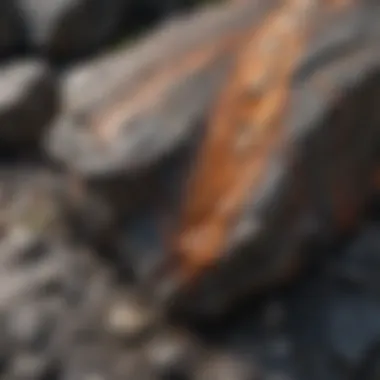
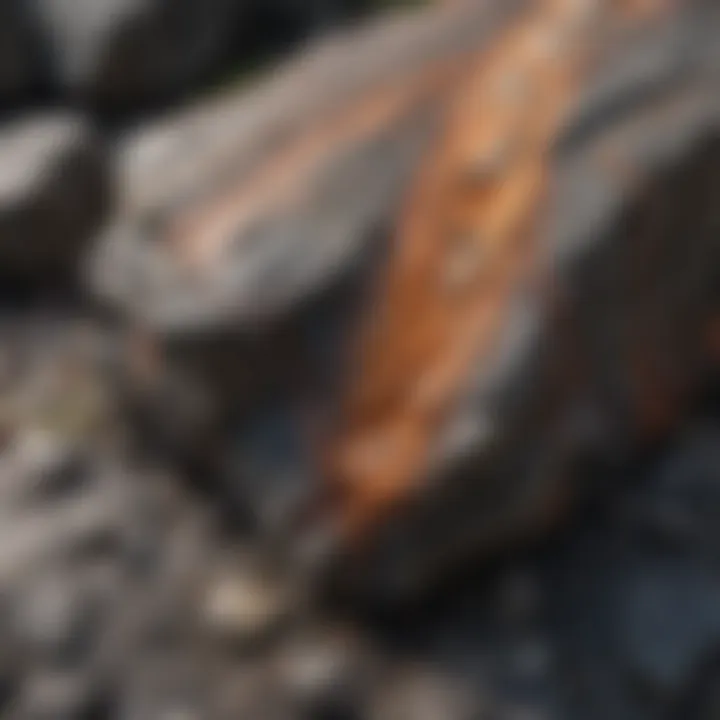
Intro
Metamorphic rocks have a compelling story to tell. They are the product of geological processes that transform existing rocks through heat, pressure, and chemical interactions. This metamorphosis creates unique textures and mineral compositions distinct from their parent materials. Their study is particularly engaging for geology enthusiasts and collectors, as identifying these rocks not only deepens one’s understanding of Earth’s processes but can also lead to extraordinary finds.
By the end of this guide, you will be equipped with the tools to recognize and classify metamorphic rocks confidently. We will explore their history, significance, key characteristics, and practical identification methods, all presented to enhance your tactile experience in the field.
History and Origins
Overview of Collectibles, Rocks, and Fossils
Understanding metamorphic rocks begins with a glance back at the history of geology. Collectors have long sought after specimens, driven by curiosity and the intrinsic beauty of these minerals. Each rock holds a fragment of history, providing clues to the dynamic processes that have shaped our planet over millions of years.
In the realm of collectibles, metamorphic rocks stand out for their intricate patterns and rich textures. From schist with its shiny mica flecks to gneiss, displaying bands of minerals, these rocks are both an aesthetic delight and a field of study. Collecting these rocks not only adds beauty to your collection but can also reveal a wealth of geological information.
Historical Significance and Cultural Impact
There is more to metamorphic rocks than meets the eye. Historically, these rocks have held significant cultural value. Ancient civilizations often utilized them for construction and sculpture. For instance, marble, a metamorphosed limestone, has graced structures and monuments across the globe, reflecting both artistic and historical narratives.
Metamorphic processes demonstrate nature’s artistic flair. Stories etched in layers help us understand ancient environments and climate conditions. As we venture into identification, it’s important to acknowledge not just the science but the rich tapestry of human history intertwined with these geological treasures.
Identification and Classification
Guide to Identifying Rocks and Fossils
Recognizing metamorphic rocks requires an eye for detail. Here are some essential features to consider:
- Texture: Look for foliation; a layered appearance suggests the rock has undergone differential stress. Non-foliated rocks like marble lack this feature.
- Mineral Composition: Identify minerals; common ones include garnet, quartz, and amphibole. Their presence can suggest the conditions under which the rock formed.
- Color Variations: Observe the colors—these can often hint at the mineral components and the degree of metamorphism.
Familiarizing oneself with these characteristics turns the identification process into an adventure, almost like a detective unraveling a mystery.
Common Types and Variations
There are several types of metamorphic rocks you might encounter:
- Slate - Known for its fine-grained texture, often gray or black, used in roofing.
- Schist - Coarser than slate, marked by visible crystals, typically micas like biotite or muscovite.
- Gneiss - Characterized by banded minerals; its distinct patterns often mimic the semblance of zebra stripes.
- Marble - A product of limestone, it is revered in art and architecture, often displaying a creamy finish with veining.
- Quartzite - Formed from sandstone, it’s resistant to weathering and has a glassy texture.
When identifying metamorphic rocks, always consider the context in which the rock appears. The geological environment provides valuable clues to its history.
The beauty of recognizing these rocks lies not only in the variety but in their stories. Each specimen is a window into Earth’s transformative powers, beckoning collectors and enthusiasts to dig deeper into their geology. Throughout this guide, we will continue to piece together these narratives, enhancing both appreciation and knowledge of these fascinating rocks.
Intro to Metamorphic Rocks
Understanding metamorphic rocks is pivotal for anyone with an inclination towards geology or the natural sciences. These rocks not only serve as a record of Earth’s evolutionary narrative but also showcase the intricate processes transforming basic minerals into diverse and often stunning structures. Comprehending the characteristics and formation of these rocks allows enthusiasts and collectors to appreciate their complexity and beauty.
Definition and Characteristics
Metamorphic rocks arise from the transformation of existing rock types, termed parent or protoliths, under conditions of high pressure and temperature. This metamorphosis alters the mineral composition and structure without the rock melting, making these rocks unique. What sets them apart is their layered appearance, and in some cases, a distinct mineral alignment known as foliation.
Common characteristics include:
- Foliated vs. Non-Foliated: Foliated rocks show visible layers or stripes, like schist or gneiss, while non-foliated types, such as marble or quartzite, lack this banded appearance and might look more uniform.
- Texture: The texture can vary widely – from the coarse grains of gneiss to the fine, even texture of slate. This texture reflects the conditions of pressure and temperature they endured.
- Color: Metamorphic rocks can exhibit a broad spectrum of colors, often influenced by their mineral makeup.
Adding these layers of complexity and variety, metamorphic rocks tell geographical tales that can span millions of years.
Formation Processes
The formation of metamorphic rocks is a tale of tumultuous geological activities. This process typically involves agents such as heat, pressure, and chemically active fluids, which play vital roles in metamorphosing the parent rock.
Key processes include:
- Contact Metamorphism: Occurs when rocks are heated by nearby molten magma or lava. This scenario often results in localized changes, forming rocks like marble from limestone due to the intense heat nearby.
- Regional Metamorphism: This type arises from high pressure and temperature over large areas, commonly during mountain-building events. The forces involved can push rocks deep into the Earth’s crust, causing profound transformations.
- Hydrothermal Metamorphism: Here, hot, chemically active fluids percolate through rocks, often changing their mineral compositions. An example is the transformation of basalt to chlorite schist under specific conditions.
Each of these processes contributes uniquely to the diversity of metamorphic rocks found in nature, making them a fascinating subject for geologists and collectors alike.


Types of Metamorphic Rocks
Understanding the types of metamorphic rocks serves as a cornerstone for anyone interested in geology, especially for rock and fossil collectors. The diversity of metamorphic rocks can be impressive, and deciphering their characteristics hints not only at their origin but also at the forces that transformed them. This section highlights two primary classifications: foliated and non-foliated metamorphic rocks. Each category has unique characteristics and formation stories, providing invaluable insights into geological processes and the Earth's history.
Foliated Metamorphic Rocks
Foliated metamorphic rocks are known for their layered appearance, with minerals aligned in planes due to pressure. This characteristic offers a visual narrative of the rock's transformation process. Foliation creates structure that can indicate the intensity and direction of tectonic forces at play. These rocks often catch the eye of both collectors and geologists alike.
Examples
Examples of foliated metamorphic rocks include schist, slate, and gneiss. Each example tells a different tale:
- Slate: A fine-grained rock that is often used in roofing and flooring. Its ability to split into smooth sheets makes it incredibly popular in construction.
- Schist: Contains larger grains and often exhibits a shiny appearance due to the presence of mica. This can make it appealing for collectors.
- Gneiss: Features bands of alternating colors and can be visually striking, making it a sought-after specimen.
The key characteristic of these examples lies in their ability to show the directional pressure that resulted in foliation. These rocks can be a beneficial choice for collectors because they often exhibit unique appearances and textures, making them eye-catching pieces for display.
Formation Conditions
Foliated metamorphic rocks typically form under high pressure and temperature conditions, which often occur during regional metamorphism associated with tectonic activity. This geological setting leads to the segregation of minerals into bands and layers. The distinctive feature of this formation is the alignment of minerals which happens as they recrystallize under directional pressure.
The unique aspect of foliated rocks is their indication of ancient forces within the Earth. For collectors, understanding these conditions can enhance appreciation of each piece, making them not just rocks, but historical artifacts. However, the anisotropy of foliation can sometimes complicate their use in certain applications, especially in construction where uniform strength is required.
Non-Foliated Metamorphic Rocks
Non-foliated metamorphic rocks, unlike their foliated counterparts, do not exhibit layering. This category features a more homogenous structure and is often formed in environments of uniform pressure.
Examples
Examples of non-foliated metamorphic rocks include marble and quartzite. These rocks possess distinct features:
- Marble: Formed from limestone, marble is prized for its aesthetic qualities and is used in sculpture and architecture. Its ability to take a high polish works to its advantage in the art world.
- Quartzite: Formed from sandstone, this rock is notably hard and often used in decorative stones and construction due to its durability.
The primary characteristic here is their lack of foliation, which arises from different metamorphic conditions. This makes them easy to recognize, and their aesthetic appeal can be quite lucrative for collectors and builders alike.
Formation Conditions
Non-foliated metamorphic rocks typically form in environments where pressure is applied equally from all directions, often through contact metamorphism or when sedimentary rocks are buried deep within the Earth. This results in a solid, uniform texture without the layered appearance. The unique trait of these formation conditions speaks to a different set of geological processes.
For collectors, understanding the formation of these rocks can provide a deeper connection to the natural forces at play. While they may lack the striking banding found in foliated rocks, their unique qualities afford them significant value and appeal within both geological and commercial realms.
The types of metamorphic rocks serve as a lens through which one can view the dynamic processes that shape our planet, shedding light on past geological events and helping us appreciate the variety of forms that these rocks take.
Key Features for Identification
Recognizing metamorphic rocks involves understanding various key features that signal their identity. These features serve as essential clues that help geologists and rock enthusiasts to categorize and appreciate the intricate processes behind each rock's formation.
Texture, for instance, is a significant characteristic that contributes not only to the aesthetic appeal of the metamorphic rock but also reflects its formation history. Understanding the texture can unveil subtle nuances about the conditions under which the rock was formed. Mineral composition complements this by revealing the specific minerals that define the rock type, shedding light on its parent material and the evolutionary path it undertook. Thus, gaining familiarity with these attributes is vital for accurate identification and classification.
"What lies beneath the surface often tells a deeper story than what meets the eye."
Texture
Texture is the feel and appearance of rocks, closely tied to their formation processes. In metamorphic rocks, texture can vary significantly based on the minerals present and the conditions of metamorphism. Different textures can lead to different methods of identification.
Granoblastic Texture
Granoblastic texture is a key feature present in several metamorphic rocks, characterized by equidimensional grains of minerals. This texture often means that the rock has undergone high-grade metamorphism, where temperatures and pressures are elevated.
A primary characteristic of granoblastic texture is uniformity; the mineral grains are generally similar in size, giving the rock a cohesive look. This makes the granoblastic texture quite beneficial for identification purposes, as enthusiasts can easily recognize it and distinguish it from the more layered textures found in other metamorphic rocks. However, the advantage of this texture also comes with a disadvantage, as its homogeneity may at times obscure the identity of specific minerals within the rock.
Schistose Texture
Schistose texture is another crucial feature commonly observed in metamorphic rocks. This texture consists of well-defined layers or schistosity, caused by the parallel alignment of platy minerals such as mica. Schistose texture often hints at lower to intermediate-grade metamorphism.
A key characteristic of schistose texture is its layered appearance, which not only makes schist visually striking but also simplifies identification for rockhounds. Its angular and shiny surfaces make it recognizable even from a distance. However, the distinct layering can sometimes lead to confusion, as the presence of different minerals can create a variety of color patterns, making precise identification less straightforward.
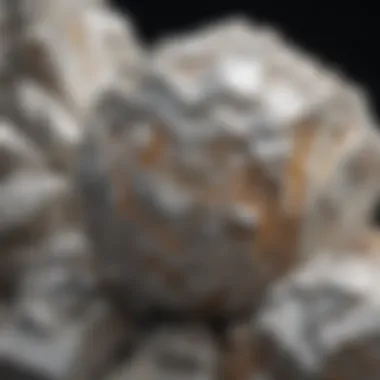
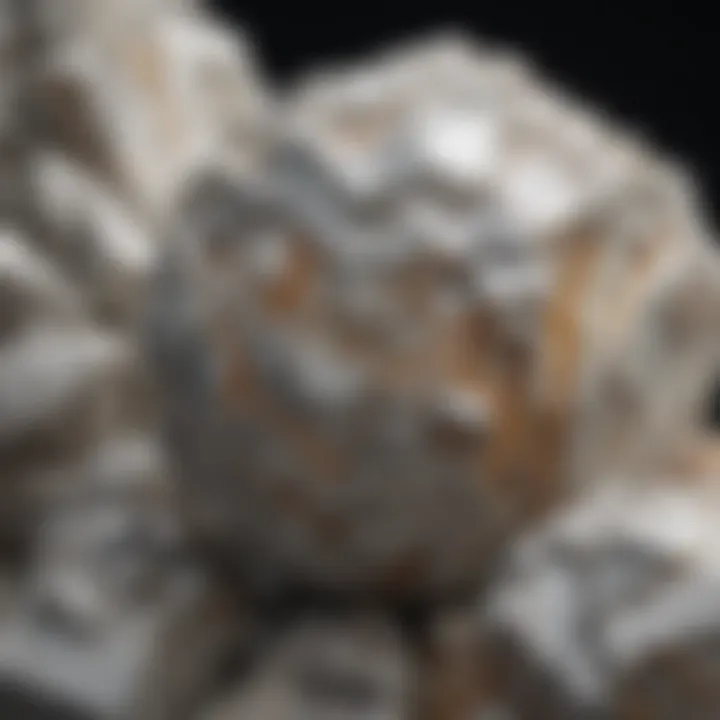
Gneissic Texture
Gneissic texture represents a high-grade metamorphic rock that features alternating layers of light and dark minerals. This banding is typically the result of high temperature and pressure conditions, allowing minerals to segregate based on their physical properties.
A standout characteristic of gneissic texture is its striking visual appeal due to the layered, banded patterns, which can range from subtle to stark contrasts. This makes it an attractive choice for collectors and geologists alike, as such patterns are not typically seen in other rock types. However, the very nature of gneissic texture, while beautiful, can pose challenges when attempting to determine the specific mineral composition without detailed analysis.
Mineral Composition
Mineral composition plays a pivotal role in the identification of metamorphic rocks. It encompasses the variety and arrangement of minerals that constitute the rock, directly influencing its classification and physical characteristics.
Common Minerals in Metamorphic Rocks
The presence of specific minerals in metamorphic rocks is a crucial indicator of their identity. Common minerals such as quartz, feldspar, and components of the mica group frequently appear in these rocks, each providing unique characteristics that aid in identification.
A notable aspect of these common minerals is their stability under metamorphic conditions, which grant the rock its resilience. Recognizing these minerals can provide clues to the rock's parentage and environmental conditions. However, while prevalent, their abundance can sometimes lead to ambiguity in classification due to shared characteristics among different rock types.
Influence of Parent Rock
The influence of the parent rock on the resulting metamorphic rock is an essential consideration. Understanding the original rock can inform one about the metamorphic processes that took place, effectively tying together the features observed in the metamorphic specimen.
One of the strengths of investigating parent rock influence is its ability to reveal the history and conditions under which the metamorphic transformation unfolded. However, potential misidentification can arise if there is an insufficient understanding of the parent material's characteristics, leading to incorrect conclusions about the metamorphic rock itself.
Field Identification Techniques
When one sets out to identify metamorphic rocks, field identification techniques become essential tools in the geological toolkit. Understanding how to accurately assess a rock's characteristics in the field aids enthusiasts and collectors in distinguishing between various metamorphic types. The approaches discussed here contribute not only to proper identification but also enhance the appreciation of these complex geological formations.
Visual Assessment
Color
Color can often speak volumes about a rock's identity. In metamorphic rocks, color can reflect their mineral composition. For instance, minerals like garnet give some schists a distinct reddish hue, while chlorite-rich rocks might have greenish tones. This visual guide can serve as an initial flag, hinting at what lies beneath the surface.
Utilizing color as an identification marker is practical as it allows for quick visual categorizations. However, one must exercise caution. Different minerals can show up in various forms under changing light conditions, so it’s advisable to corroborate color observations with additional examination techniques.
The unique feature of color is its subjective nature; different observers may perceive shades differently, adding another layer of complexity. Still, it remains a vastly beneficial and accessible starting point in identifying metamorphic specimens.
Layering and Banding
Layering and banding are crucial indicators in the metamorphic world. These characteristics inform us about the rock's history of pressure and temperature during the metamorphism process. Layering refers to distinct, parallel planes within a rock, while banding typically involves alternating different colors or mineral compositions.
Such patterns are particularly common in foliated rocks, where mineral grains align due to directional pressure. This feature can signal significant geological events, shedding light on tectonic movements that shaped the Earth's crust. Observing these formations allows rock collectors to not only identify rocks but also to understand their geological narrative.
While layering and banding are insightful, they may not be as prominent in non-foliated rocks. Therefore, while highly useful in certain contexts, this method needs to be supported by other identification techniques for a more comprehensive analysis.
Physical Properties
Hardness Testing
Hardness testing is a cornerstone of rock identification processes. This technique measures a rock's resistance to scratching, influenced by its mineral content. The Mohs hardness scale, which ranks minerals from talc (1) to diamond (10), provides a practical framework for such assessments. For example, schist may score around a 4 due to its softer mica content, whereas a quartzite might coast in at a robust 7 owing to its quartz composition.
This method proves popular due to its simplicity and effectiveness in establishing a rock's identity. However, hardness testing can pose challenges when a rock features varying hardness levels in different spots, making it necessary to gauge multiple areas for accuracy. Thus, while invaluable, this technique must be complemented with other methods for definitive identification.
Cleavage and Fracture Patterns
Cleavage and fracture patterns represent another vital aspect of identifying metamorphic rocks. Cleavage relates to how a rock breaks along specific planes of weakness, revealing its internal structure. Rocks like schist often exhibit excellent cleavage, easily splitting along their foliation planes. In contrast, fracture patterns are more random, occurring in rocks like quartzite, which lack such directional weaknesses.
These characteristics help enthusiasts determine how a rock may react to external forces—an essential consideration in various applications, from construction to sculpture. The debate arises with how much cleavage or fracture influences overall identification; a rock with minimal observable cleavage might still reveal significant clues through fracturing if analyzed under the right conditions.
In summary, recognizing metamorphic rocks involves combining visual assessments such as color and layering, along with physical properties like hardness and cleavage patterns. Each technique provides a piece of the identification puzzle, allowing rock collectors to develop a richer understanding of these geologically intricate treasures.
Geological Context
Understanding the geological context is crucial when identifying metamorphic rocks. It establishes the broader backdrop against which these rocks formed. Context can inform enthusiasts and collectors about the specific environments where different metamorphic types exist. By grasping how tectonic settings and metamorphic grades intertwine, one can make better predictions about the characteristics and classifications of these rocks. Knowing the geological history can also provide insights into revealing features, helping to distinguish between forms that might otherwise seem similar at a glance.
Tectonic Settings
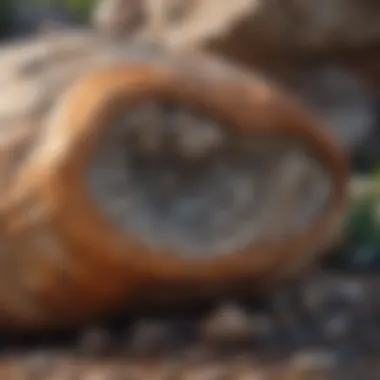

Subduction Zones
Subduction zones are fascinating geological features where one tectonic plate moves under another, sinking into the Earth's mantle. This process contributes significantly to the formation of certain metamorphic rocks, especially those in volatile environments. The typical characteristics of subduction zones include high pressure coupled with relatively low temperatures, leading to unique metamorphic processes.
The benefit of focusing on this type of tectonic setting is that it often produces a distinctive assortment of metamorphic rocks, like blueschist and eclogite. These rocks inform collectors about the conditions under which they formed. A peculiar aspect of subduction zones is the way they can lead to diverse mineral assemblages depending on the parent rock composition.
However, collecting rocks from these settings can be challenging due to their often remote locations.
Continental Collision
Continental collision occurs when two continental plates push against each other, leading to significant geological upheaval. This is another critical aspect in metamorphic rock formation, as immense pressure and temperature changes can morph existing rocks profoundly. The key characteristic here is the depth at which these processes occur, often buried under miles of rock.
The advantages of studying metamorphic rocks formed in continental collisions include them often displaying pronounced foliation, providing strong clues about their history. Example rocks produced from this setting, like gneiss and schist, are usually well sought after for both their beauty and their complex histories. A downside might be that the types of metamorphism are more varied and can complicate identification.
Metamorphic Grade
Low-Grade Metamorphism
Low-grade metamorphism occurs under lower temperatures and pressures compared to high-grade metamorphism and plays a significant role in the formation of certain metamorphic rocks like slate. One interesting aspect of low-grade conditions is that they often preserve characteristics of the parent rock more than their high-grade counterparts do.
This is helpful for geologists since the identification of low-grade metamorphic rocks can lead to insights about the initial rock types. Not to mention, these rocks tend to be more accessible for hobbyists and collectors, providing an easier entry point for those looking to learn more about metamorphic processes.
High-Grade Metamorphism
High-grade metamorphism, on the other hand, occurs where extremely high temperatures and pressures prevail, producing rocks such as gneiss or schist. These conditions commonly result in significant recrystallization, leading to more visually striking specimens that are sometimes more desirable for collectors. High-grade rocks tend to exhibit unique textures and mineral compositions, providing a rich field of study for enthusiasts.
While the gracefulness of high-grade metamorphic rocks makes them appealing, the environments in which they form can be harder to access or harvest materials from, limiting what can be practically collected.
"Understanding the geological context can transform a simple observation of a rock into a profound story about Earth’s history."
In summary, both tectonic settings and metamorphic grades provide essential insights into the identity and classification of metamorphic rocks. Knowing where and how these rocks form can deepen the appreciation and understanding for collectors and anyone fascinated by geological wonders.
Practical Applications
Metamorphic rocks are not only fascinating geological specimens but also serve a multitude of practical purposes. Understanding these rocks' applications is essential for geologists, engineers, and artists alike. Their unique properties often translate into benefits that extend well beyond academic interest, impacting infrastructure, art, and even cultural heritage.
Utilization in Construction and Art
The durability and aesthetic appeal of metamorphic rocks make them a top choice in construction. For instance, slate, a common metamorphic rock, is utilized for roofing tiles and flooring. Its ability to be split into thin sheets offers an advantage, providing not only strength but also versatility in design. Furthermore, granite, another metamorphic rock, is often used for countertops and monuments due to its resistance to weathering and erosion.
In the realm of art, metamorphic rocks have inspired countless artisans. Sculptors often gravitate towards marble – the metamorphosed form of limestone – for its workability and beautiful appearance. The classic white marble, famously used by Michelangelo, demonstrates how these materials can blend functionality with artistry. The myriad of colors and patterns found in metamorphic rocks adds richness; artists utilize these features to create unique, visually captivating works.
"Metamorphic rocks can transform raw nature into stunning human creations, from architectural wonders to fine art."
The construction industry's reliance on specific metamorphic rocks also emphasizes the importance of understanding their geological properties. The rock's texture, porosity, and strength must be assessed to ensure compliance with safety standards in large-scale construction projects. The selection of metamorphic rock types is crucial, often relying on geological surveys and assessments of local resources.
Cultural Significance
Beyond their tangible uses, metamorphic rocks hold significant cultural importance across various societies. Many cultures have revered these rocks, associating them with strength, endurance, and longevity. Historically, craftsmanship in cultures around the world has utilized locally available metamorphic stones for buildings, monuments, and sacred structures.
In the realm of indigenous peoples, particular metamorphic stones have been used ceremonially. For example, the use of granite in ancient temples reflects not just practicality but a deeper connection to the earth and the natural world. The presence of specific metamorphic rocks can be a point of historical interest, revealing insights into human migration, trade routes, and the evolution of architectural styles.
Additionally, artifacts made from metamorphic rocks often become treasured heirlooms, linking generations together. For rock collectors and enthusiasts, this cultural significance heightens their appreciation of these materials. Each specimen tells a story, blending natural history with human history.
The dual nature of metamorphic rocks – as both practical materials and cultural symbols – underscores their value in our lives. Engaging with these rocks allows collectors and geologists to cherish not just their beauty but also their multifaceted roles in both nature and human society.
Closure
In the study of metamorphic rocks, understanding the techniques and methods for identification is paramount. This article has underscored the significance of knowing how to recognize these geological formations effectively. It's not just about tossing around terms like foliated or non-foliated; it's about grasping the underlying processes that shape each rock's character. Identifying metamorphic rocks allows enthusiasts and collectors to appreciate the intricate history locked within each specimen. It transforms a simple piece of rock into a story of heat, pressure, time, and minerals reformed.
Recap of Identification Methods
To properly identify metamorphic rocks, one must consider several critical methods:
- Visual Assessment: Look into the color, layering, and banding of the rocks. For instance, schist often exhibits shiny grains, while gneiss displays distinct light and dark banding.
- Physical Properties: Evaluate the hardness by employing common hardness tests, like the scratch test. Cleavage and fracture patterns can also clinch the identity of the rock.
- Examine Texture: Whether it be granoblastic, schistose, or gneissic, each texture reveals much about the rock's history and formation conditions.
- Mineral Composition: Analyzing the minerals present, alongside considering the parent rock, provides vital clues on how environmental factors contributed to the metamorphic process.
In wrapping up these methods, one realizes that the recognition of metamorphic rocks is a blend of observable traits and underlying geological narratives.
Encouragement for Further Exploration
For those who find joy in geological pursuits, I encourage you to keep digging deeper. Venture beyond basic identification; immerse yourself in the stories each rock has to tell. Attend geology clubs or online forums, such as those found on Reddit or Facebook, where fellow enthusiasts share insights and discoveries. Not only will you enhance your knowledge, but you may also connect with mentors or peers to discuss fascinating locations to explore.
Explore relevant literature, whether it be scholarly articles from Britannica or the vast resources available on Wikipedia. Each rock, each layer beneath your feet, has been sculpted through time, pressure, and heat. Equip yourself with the skills and curiosity to unveil these stories, and the world of metamorphic rocks will unfold before you.



